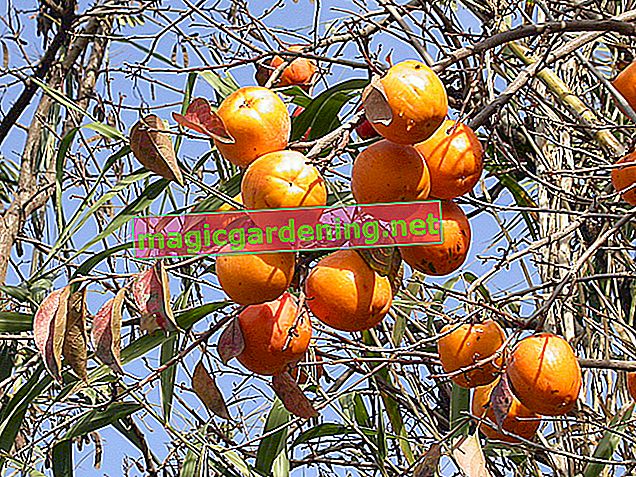
The exotic kaki tree is an ebony plant native to Asia. It is a large tree with elongated leaves and yellow and white flowers. Its apple-sized fruits are mostly orange in color and taste very sweet and juicy when ripe. The immature persimmons leave a furry feeling on the tongue.
also read
- Growing a persimmon tree from seeds
- Persimmon trees are not hardy
- Variety of varieties in the persimmon trees
Various breeds are offered in German supermarkets all year round:
- Persimmon (large, round, sweet, very soft flesh),
- Persimmon (smaller and more intensely colored than persimmon, firm flesh),
- Sharon (flat, tomato-like shape).
The fruits are harvested unripe and can be stored well. Sharon fruits and persimmons can also be consumed unripe, as they contain practically no tannins.
Free-range husbandry is only possible in wine-growing areas
Diospyros kaki is not hardy. However, cultivation is possible in Germany's mild winter wine-growing regions. Keeping them in a bucket is also recommended there in the first years of standing. Older plants can be planted in a sunny spot in the garden. For most areas of Germany, due to the low winter hardiness of Diospyros kaki, only the bucket culture is considered. The frost-resistant genus Diospyros virginiana is particularly well suited for the local climate. Its fruits are slightly smaller, but the tree also delivers good yields outside of the wine-growing areas.
Hibernate persimmon trees without frost
Depending on the variety, the persimmon trees have different frost resistance. The plants that are suitable for outdoor cultivation can cope with the occasional night frost, but need winter protection in particularly cold winters. The persimmon plants growing in the tub - after they have lost their leaves and the fruits have been harvested - overwintered frost-free and dark. During the hibernation, there is no fertilization and only very sparingly watered.
Tips & Tricks
The easy-care kaki plant thrives best on the neutral and on the loamy soil. It can be raised as a half and high trunk as well as on a trellis. The fruits are ripe between October and November.








